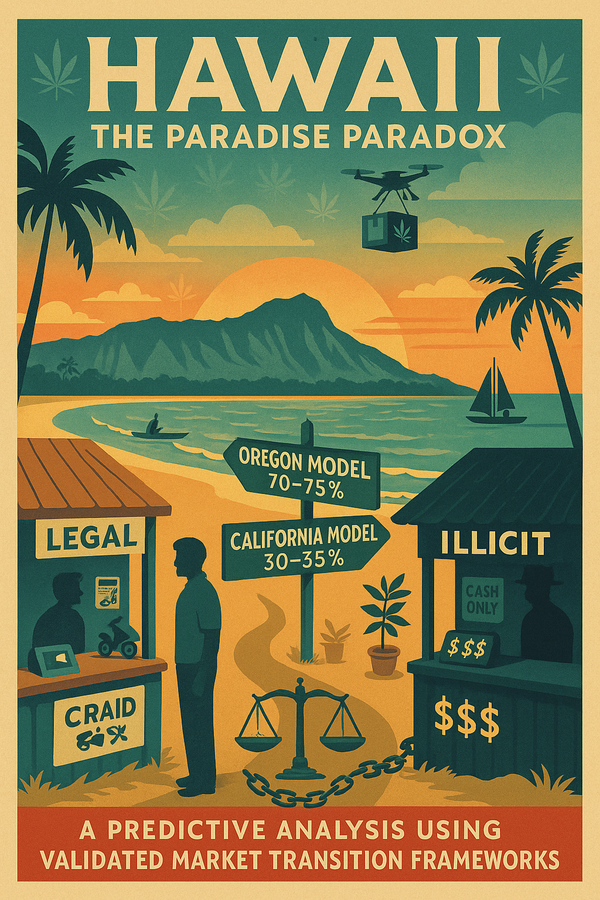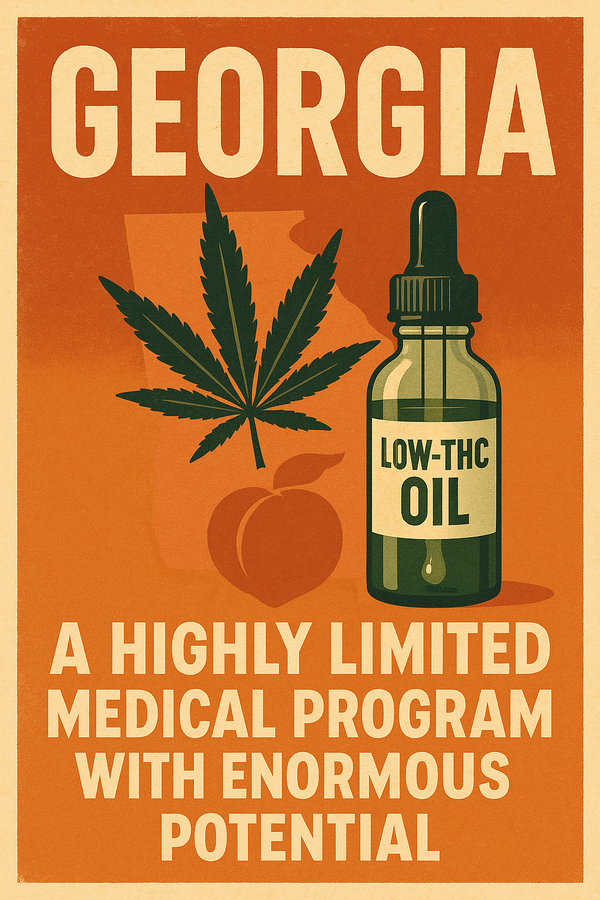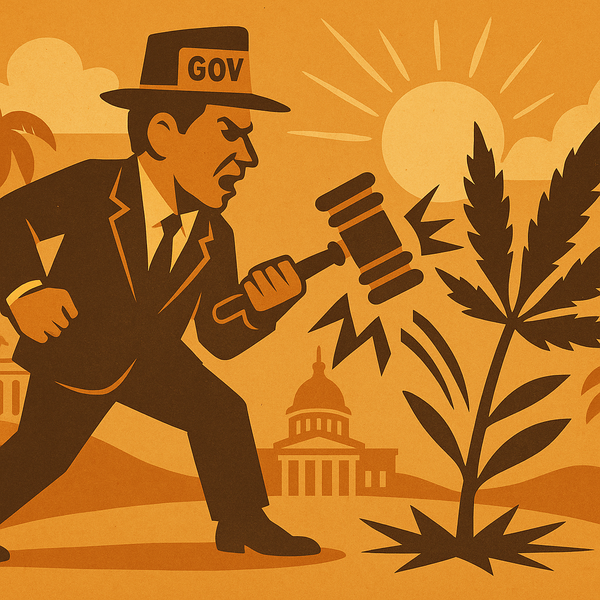The Home Grow Myth: Why Your Closet Costs More Than Dispensary Weed

Everyone calculates nutrients and lights. No one calculates the closet. That 4×6 space isn’t free — it’s real estate with an opportunity cost. And when you account for what that space is actually worth, home grow economics collapse before you even flip the switch.
© The Silent Majority, 2025
Part 1 of The Cannabis Moat Series™
The Calculation Everyone Misses
Walk into any home grow forum and you’ll see the same math:
- “Lights: $300”
- “Nutrients: $100”
- “Electricity: $150”
- “Total: $550 for a pound of weed!”
What you won’t see:
- “Closet opportunity cost: $720/year”
That’s the insight no one is pricing in. And it’s the reason home cultivation can’t compete with dispensaries — even before counting the 100+ hours of labor you’ll invest.
The Disclaimer: We’re Being Conservative
This analysis uses direct economic costs (equipment, inputs, electricity, genetics) plus real estate opportunity cost — the factor everyone else ignores.
What we’re STILL not counting:
- Your labor (100+ hours per grow = $5,000/lb at median wage)
- Strain variety limitations (locked into 1–2 strains for months)
- Time value of money
- Convenience premium (16 weeks vs. 15 minutes)
Why? Because even without labor, the math doesn’t work. The closet alone kills the economics.
And if home grow fails this test, the black market fails even harder.
Section 1: The Real Estate Tax Nobody Calculates
Your Closet Isn’t Free
Based on Zillow’s national rental data, the median rent per square foot in the U.S. is $2.50/month.
A typical grow closet = 24 square feet (4×6)
Annual opportunity cost:
- 24 sq ft × $2.50/month = $60/month
- $60 × 12 months = $720/year
If you complete 3–4 grows per year (standard for home growers):
- $720 ÷ 3.5 grows = $205 per grow
- At 1 lb yield per grow = $205/lb in real estate cost
Using a Spare Room? It Gets Worse
A 10×10 spare room = 100 square feet
Annual opportunity cost:
- 100 sq ft × $2.50/month = $250/month
- $250 × 12 months = $3,000/year
- $3,000 ÷ 3.5 grows = $857 per grow = $857/lb
What That Space Is Actually Worth
That closet or spare room could be:
- Rented out (Airbnb, roommate) = $500–1,500/month in many markets
- Home office (tax deduction) = $200–400/month value
- Storage (avoiding storage unit fees) = $100–200/month
- Guest bedroom (family visits, property value)
When you dedicate that space to cannabis for 12–16 weeks at a time, you’re paying an invisible premium.
This is the cost everyone forgets. And it’s not optional.
Section 2: The Direct Costs (Before Real Estate)
Based on data from Cannabis Business Times and Cannabis Business Plans, here’s what basic home cultivation requires:
One-Time Setup Costs (6-plant grow)
Equipment investment:
- Grow tent (4×6): $150–300
- LED grow lights (600W): $200–400
- Ventilation system (fan + carbon filter): $100–200
- pH meters, timers, hygrometer: $100–150
Total initial investment: $550–1,050
Amortized over 4 grows: $140–260 per grow
Per-Grow Consumable Costs (16-week cycle)
Every single grow requires:
- Genetics (quality seeds or clones): $50–100
- Nutrients (vegetative + flowering): $100–150
- Growing medium (soil or coco coir): $50–100
- Electricity (600W × 18hr/day veg + 12hr/day flower × 16 weeks): $150–200
Total consumables per grow: $350–550
Combined Direct Costs (Before Failure Adjustment)
Per-grow total: $490–810
At 1 lb yield: $490–810/lb in direct costs
Section 3: The Failure Tax
According to Dixon Wellness Collective, the most common reasons home grows fail include:
The Top 10 Killers:
- Overwatering or underwatering
- Incorrect pH levels (nutrient lockout)
- Nutrient burn or deficiency
- Light stress (too close or too far)
- Pest infestations (spider mites, fungus gnats)
- Mold and mildew (humidity control failure)
- Hermaphroditism (stress-induced male flowers)
- Harvesting too early or too late
- Poor drying and curing technique
- Temperature and humidity fluctuations
Industry estimates: 20–30% of home grows produce unusable or severely reduced yields.
The Math of Failure
If 1 in 4 grows fails or produces <50% expected yield:
You need to amortize costs across successful grows:
- Direct costs per attempt: $490–810
- Success rate: 75%
- Adjusted cost: $490–810 ÷ 0.75 = $650–1,080/lb
This isn’t pessimism. It’s reality. First-time growers routinely lose entire crops to preventable mistakes.
Section 4: Adding Real Estate = Game Over
Total Cost Per Pound (Direct + Real Estate)
Closet grow (24 sq ft):
- Direct costs (adjusted for failure): $650–1,080/lb
- Real estate opportunity cost: $205/lb
- Total: $855–1,285/lb
Spare room grow (100 sq ft):
- Direct costs (adjusted for failure): $650–1,080/lb
- Real estate opportunity cost: $857/lb
- Total: $1,507–1,937/lb
And We STILL Haven’t Counted Labor
100+ hours of work per grow includes:
- Daily watering and pH checks (30 min/day × 112 days = 56 hours)
- Weekly nutrient mixing and feeding (1 hour/week × 16 weeks = 16 hours)
- Training and pruning (10 hours)
- Harvesting (8 hours)
- Trimming (12–20 hours)
- Drying and curing monitoring (8 hours)
Total time investment: 110–120 hours
At median U.S. wage (BLS data = $50/hr):
Labor cost: 115 hours × $50/hr = $5,750/lb
True All-In Cost of Home Grow
Closet grow: $855–1,285 + $5,750 = $6,605–7,035/lb
Spare room grow: $1,507–1,937 + $5,750 = $7,257–7,687/lb
But even if you ignore labor and only count direct costs + real estate:
Home grow costs $855–1,937/lb depending on space used.
Section 5: The Quality Gap
Dispensary cannabis undergoes comprehensive testing. Here’s what Trulieve’s lab reports show for a single strain (Dream Hunter, tested by ACS Laboratory):
Every Batch Gets Tested For:
Potency analysis:
- Total THC: 29.78%
- Full cannabinoid profile (THCA, CBD, CBG, CBN)
- Terpene analysis: 2.05% total (8 identified compounds)
Safety testing:
- Heavy metals (arsenic, cadmium, lead, mercury): All below detection limits
- Mycotoxins (aflatoxins, ochratoxin): None detected
- Pesticides: 69 compounds tested, all below detection limits
- Microbiology (E.coli, salmonella, aspergillus): Absence confirmed
- Moisture content and water activity: Optimized for storage
Home Growers Get:
- No lab testing
- No potency verification
- No contaminant screening
- No quality assurance
- No batch-to-batch consistency
Your THC percentage? You’re guessing.
Pesticide residue? You’ll never know.
Mold spores? Hope you dried it properly.
Section 6: The Variety Problem
According to research in the National Library of Medicine, cannabis consumers use multiple ingestion methods and product formats regularly:
How People Actually Consume Cannabis:
- Flower (smoking, vaporizing)
- Concentrates (dabs, wax, shatter, rosin)
- Edibles (gummies, chocolates, baked goods, beverages)
- Tinctures (sublingual drops, capsules)
- Topicals (creams, balms, patches)
- Pre-rolls (convenience, variety packs)
Dispensaries Offer:
- 50–100+ different strains
- 10+ product formats
- Consistent potency and dosing
- Immediate availability
- New releases monthly
Home Growers Get:
- 1–2 strains per 16-week cycle
- Flower only (unless you learn solventless extraction)
- No dosing precision
- 4-month commitment to the same genetics
You can’t home-grow a gummy. You can’t home-grow variety.
Section 7: The Dispensary Comparison
Let’s be completely fair and include ALL costs consumers face when buying retail:
Florida Dispensary Purchase (Example):
Retail pricing:
- $25–35 per 1/8 oz
- $200–280 per ounce
- $3,200–4,480 per pound equivalent
Additional buyer costs:
- Sales tax or Medical RX Cost (6–10% in Florida): $192–448
- Drive time (30 min round trip): $25 at $50/hr opportunity cost
- Gas (10 miles): $4
Total all-in: $3,421–4,957/lb equivalent
But Here’s The Key:
Consumers don’t buy pounds. They buy small amounts as needed:
- Typical purchase: 1/8 to 1/4 oz every 1–2 weeks
- Storage requirements: minimal
- Spoilage risk: near zero
- Variety: change strains every visit
Effective consumer experience:
- Cost per transaction: $30–40
- Time investment: 15 minutes
- Variety: unlimited
- Risk: zero
Section 8: The Real Comparison
Home Grow Reality:
Cost: $855–1,285/lb (direct + real estate, no labor)
Time required: 100+ hours
Failure risk: 20–30%
Wait time: 16 weeks from seed to smokable
Strain options: 1–2
Product formats: Flower only
Lab testing: None
Consistency: Unpredictable
Legal risk: Varies by state
Dispensary Reality:
Cost: $3,200–4,500/lb (but sold by the eighth)
Time required: 15 minutes
Failure risk: 0%
Wait time: Same day
Strain options: 50–100+
Product formats: Flower, edibles, concentrates, tinctures, topicals
Lab testing: Comprehensive
Consistency: Guaranteed batch-to-batch
Legal risk: Zero (in legal states)
The Bottom Line:
Home grow appears cheaper per pound… until you realize:
You’re comparing 16 weeks of dedicated closet space + 100 hours of labor + 25% failure risk + zero variety to walking into a store for 15 minutes.
Even hardcore cannabis enthusiasts who grow for fun will tell you: it’s a hobby, not an economic strategy.
Section 9: What This Means for the Black Market
If home grow can’t beat dispensary economics — even with conservative math and ignoring labor — then the black market is doomed.
Why Illicit Operators Face Worse Economics:
Real estate at scale:
- Home grow: closet = $205–857/lb opportunity cost
- Black market: warehouse = $10,000+/lb when operating commercial scale illegally
Failure rates:
- Home grow: 20–30% (controllable mistakes)
- Black market: 50–80% (pests, raids, seizures, theft, fires)
No brand or customer loyalty:
- Home grow: personal use, consistent quality effort
- Black market: transactional, zero trust, quality varies wildly
- Dispensaries: Build brands, loyalty programs, repeat business
Labor economics:
- Home grow: unpaid hobby (we didn’t count it)
- Black market: 24/7 operation with zero legal protections
- Effective labor cost: $0/hr with maximum life/liberty risk
The math is brutal: If closet growers can’t make it work at small scale, warehouse operators can’t make it work at commercial scale — especially when factoring in asset seizure, imprisonment risk, and complete lack of legal recourse.
Coming Next: Why the Black Market Is Collapsing Faster Than Expected
Part 2 of this series: I’ll break down exactly why illicit operators are converting to legal grows at accelerating rates — and what that means for MSO total addressable market expansion.
Spoiler: When black market operators are going legal faster than regulators projected, it’s not altruism. It’s economics. They’re losing money.
And when that transition completes, the TAM for legal cannabis is much larger than Wall Street currently models.
© The Silent Majority, 2025
Proprietary economic analysis.
Follow The Silent Majority for Part 2.




